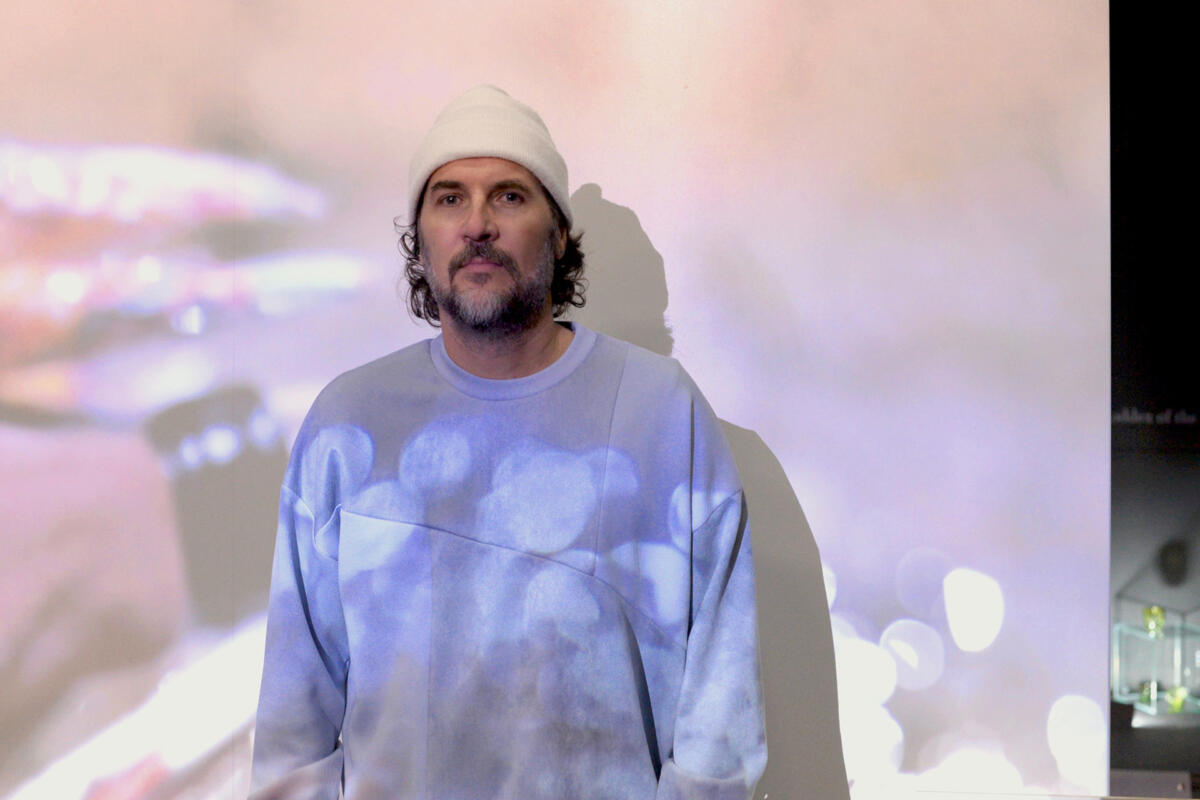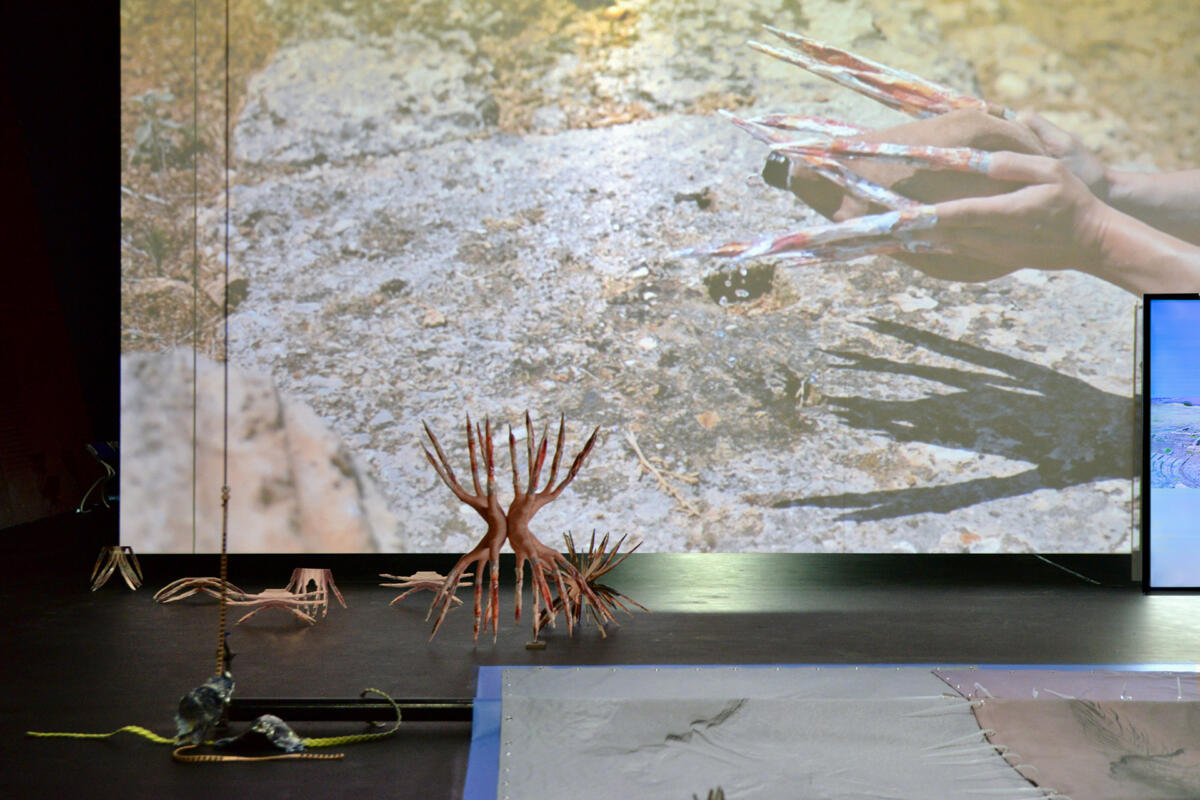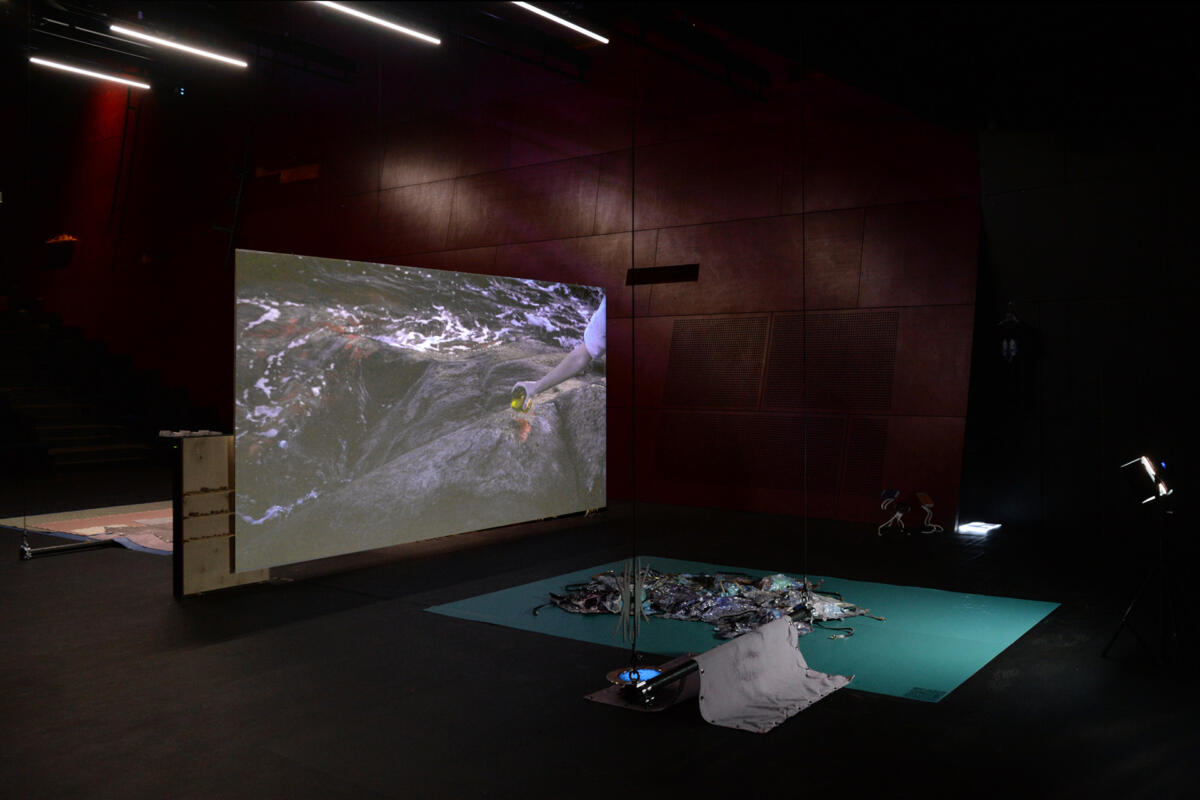Everything is expanding – Vincent Roumagnac meets us at the stage of the future
Entering Kiasma Theatre, the walls start rounding in. It seems like the whole room is in motion, and amidst the movement, an installation by artist and researcher Vincent Roumagnac sways.

DATA OCEAN THEATRE / Tragedy & the Goddexxes is the final staging of artist and researcher Vincent Roumagnac’s two-year postdoctoral artistic research. A conclusive act that combines a black-box-specific rearrangement of previous works made in collaboration with seven other artists from various art fields, and new, site-specific solo works for Kiasma Theatre.
Tragedy & the Goddexxes is an initial phase of Roumagnac’s interdisciplinary project, Data Ocean Theatre, which explores the intersection of myths, new media, and climate emergency through the transformation of seas and oceans. Over the past two years, the project, which started as a dialogue with the Finnish Meteorological Institute’s Marine Research Unit, has evolved, focusing on the alarming rise of sea levels, the exponential growth of big data – and the emotional impacts of these phenomena.
The six scenes named after Greek tragedies reimagine the concept of play through a queered and techno-animist perspective, where technology is imbued with human characteristics. Drawing from Greek tragedy’s structure, marine mythology, and “technology-as-monster” narratives, the final act introduces new works featuring mythological sea creatures and imaginary rituals.

This seems quite timely, trendy almost?
“I think that art and research, both separately and together, have a complex relationship with the time they perform in,” Roumagnac says. “These practices might reveal, as we say in French, l’époque, the epoch. Or do they, in fact, speculate the future? I tend to think of this as a type of double bind through which the produced work mirrors the contemporary time while generating alternative instances by triggering the collective imagination. I welcome both as forces within.”
“I am porous, but my work is also part of a certain time and momentum. I am playing with that too because what is theatre if not a form of play?”
Western theatre’s default setting
In Roumagnac’s work, the concept, nature, and character of theatre, stage, and the director take turns; everything oscillates.
“During my doctoral studies, I mainly challenged questions of the time-ecology of the stage,” the artist says, referring to a time-specific approach to critically studying the interactions among beings and their environment. “I was concerned with Western theatre’s default setting of ‘here and now’ – the human-centred measure and sense of time. I am still busy with the question ‘What happens to theatre if we allow more-than-human actors to take the centre of the stage? To me, this was a radical opening of the stage, as we know it, into multiagencies, multispecies, and multitemporality at play.”
The word ‘multi’ indicating a slate of thinking, doing, and applying which allows for labyrinthine-like pieces to be created. In Kiasma Theatre, the works range from site-specific scenographic objects, video works, prints, gifs, and other media. There is a certain ambivalence in the way Roumagnac plays with not only the form, materials, and methods but also the space itself. While the theatre fills with a sense of sensuality – the overall feel is ambiguous. And this is where time steps in again; it seems like the main question is: Is the work ever finished? Or are we entering in the aftermath?
Then a pop song by Elina Pirinen, Finnish dance artist and music maker, fills the space. It is Sibelius and Celine Dion – a polyphony. As the tunes float, the textures of Tragedy & the Goddexxes start slowly taking apart the stage as we know it. Tearing away multiple, inclusive layers of tradition. But make no mistake; in the quiet violence of it all, the overall experience is that of pure beauty.
With a few impurities, the artist-researcher hopes. “I do not take any responsibility for using the tricky term, beauty. But yes, the material choices and sensory qualities in the details are very important to me. In art, as well as in artistic research. Equally.”
An artist doing research
When artistic research is considered, recent discussion and polemics come to play. “People might be confused about what artistic research actually is. It is diverse research but when carried out within the academic field, it goes with a specific and shared ethos and responds to processual obligations. It is also done through art and needs to be disseminated within the academic context, and hopefully beyond.”
“The main challenges then for me come with the academia-responsive artistic research: first, to maintain and improve the qualities of the art. Secondly, to find aesthetic ways to share the research through alternative formats and creative writing, to come up with an artistic research language that complements the art and does not depend on the academic default ways of writing and presenting, while meeting the requested epistemic dimension.”
According to the artist, while art and research are able to intertwine, the difference between the two can be found in the effort of understanding the underlying methodology. The process of maintaining, documenting, and identifying ways of working to also change them to reach the outcome.
“Selecting and orienting methodology, formulating and sharing questions, opening collaborative dialogues, testing reformulations throughout the material – this is artistic research for me. I do not want to write about the results, my art or how the audience should approach or sense the artistic end product. I aim to create aesthetic objects to open experiential extensions. It is not rhetorical work, nor is it theoretical. I am not a scientist or a scholar – I am an artist, doing research.”
“Artistic research, to me, goes beyond my individualized relationship as an artist-researcher towards my objects and practice. It is about broadening the scope of experimentation by inventing other temporalities, structures, communities, and languages through new formats for sharing. This way, blurring the traditional binarisms of art/academia, artistic practice/theoretical writing. It is about attempting to build an alternative ecosystem – it is serious and playful work at the same time.”

In Kiasma Theatre, this child-like infatuation with play truly shows. The scenes are built from floating bodies, rocks from the artist’s home in the Basque Country along with golden objects that Roumagnac describes as being like “big, golden rabbit poop”. When the theatre is taken apart as a whole, alternative forms and experiences emerge. The viewer, alongside the artist, undulates away from the human-centered conventions and traditions, softly moving towards something that breathes and, like the walls of the theatre, curves. Everything queers.
“I still claim to be a theatre director. Not directing though, rather redirecting. This is theatre, a play on a stage,” the artist reminds.
“But I left straight theatre a long time ago.”
Tragedy & the Goddexxes in Kiasma Theatre was carried out in artistic collaboration with Océane Bruel, Edouard Cabay, Outi Condit, Taru Elfving, Simo Kellokumpu, Elina Pirinen & Al2be3, and Rosie Swayne during the 2023 Moving in November Festival.
Text: Elena Sulin
Photos: Vincent Roumagnac